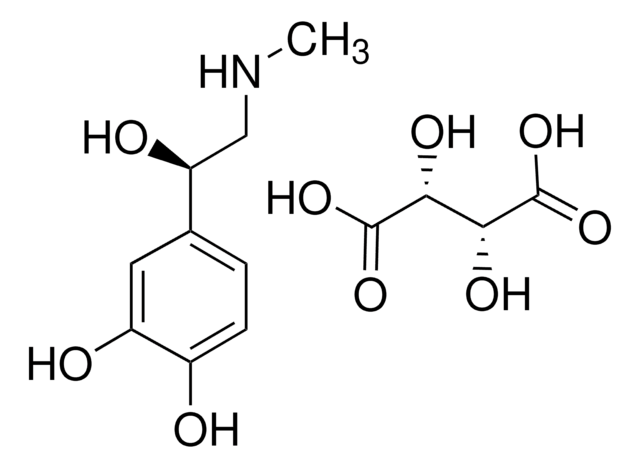A7257
(−)-Norepinephrine
≥98% (TLC), crystalline, adrenergic neurotransmitter
Sinónimos:
(R)-4-(2-Amino-1-hydroxyethyl)-1,2-benzenediol, L-Arterenol, L-Noradrenaline, Levarterenol
About This Item
Productos recomendados
product name
(−)-Norepinephrine, ≥98%, crystalline
Quality Level
assay
≥98%
form
crystalline
color
off-white to tan
storage temp.
−20°C
SMILES string
NC[C@H](O)c1ccc(O)c(O)c1
InChI
1S/C8H11NO3/c9-4-8(12)5-1-2-6(10)7(11)3-5/h1-3,8,10-12H,4,9H2/t8-/m0/s1
InChI key
SFLSHLFXELFNJZ-QMMMGPOBSA-N
Gene Information
human ... ADRA1A(148) , ADRA1B(147) , ADRA1D(146) , ADRA2A(150) , ADRA2B(151) , ADRA2C(152) , ADRB1(153) , ADRB2(154) , ADRB3(155)
rat ... Adra1a(29412) , Adra1d(29413) , Adra2a(25083) , Adrb1(24925) , Adrb2(24176) , Drd1a(24316) , Drd2(24318)
¿Está buscando productos similares? Visita Guía de comparación de productos
General description
Application
- as anαand β-AR agonist to stimulate mouse organoids to study the pathways that are activated upon intestinal epithelial adrenergic receptor (AR) stimulation,
- to measure the monoamine levels in various limbic regions of mouse brains by high-performance liquid chromatography (HPLC) coupled with an electrochemical equipped with an auto-sampler,
- as a dispersal agent in biofilm dispersion assay to study its effects on the dispersal of Mannheimia haemolytica biofilms
Features and Benefits
signalword
Danger
hcodes
Hazard Classifications
Acute Tox. 1 Inhalation - Acute Tox. 2 Dermal - Acute Tox. 2 Oral
Storage Class
6.1B - Non-combustible acute toxic Cat. 1 and 2 / very toxic hazardous materials
wgk_germany
WGK 3
ppe
Eyeshields, Faceshields, Gloves, type P3 (EN 143) respirator cartridges
Certificados de análisis (COA)
Busque Certificados de análisis (COA) introduciendo el número de lote del producto. Los números de lote se encuentran en la etiqueta del producto después de las palabras «Lot» o «Batch»
¿Ya tiene este producto?
Encuentre la documentación para los productos que ha comprado recientemente en la Biblioteca de documentos.
Los clientes también vieron
Protocolos
LC/MS/MS Analysis of Epinephrine, Metanephrine and Metabolites on Ascentis® Express OH5
Contenido relacionado
DISCOVER Bioactive Small Molecules for Neuroscience
Nuestro equipo de científicos tiene experiencia en todas las áreas de investigación: Ciencias de la vida, Ciencia de los materiales, Síntesis química, Cromatografía, Analítica y muchas otras.
Póngase en contacto con el Servicio técnico









